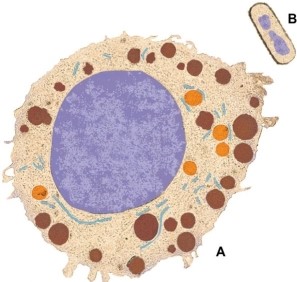Exam 1: Introduction: Evolution and Themes of Biology
Exam 1: Introduction: Evolution and Themes of Biology70 Questions
Exam 2: The Chemical Context of Life90 Questions
Exam 3: Water and Life80 Questions
Exam 4: Carbon and the Molecular Diversity of Life78 Questions
Exam 5: The Structure and Function of Large Biological Molecules117 Questions
Exam 6: A Tour of the Cell96 Questions
Exam 7: Membrane Structure and Function78 Questions
Exam 8: An Introduction to Metabolism88 Questions
Exam 9: Cellular Respiration and Fermentation117 Questions
Exam 10: Photosynthesis89 Questions
Exam 11: Cell Communication77 Questions
Exam 12: The Cell Cycle83 Questions
Exam 13: Meiosis and Sexual Life Cycles74 Questions
Exam 14: Mendel and the Gene Idea82 Questions
Exam 15: The Chromosomal Basis of Inheritance66 Questions
Exam 16: The Molecular Basis of Inheritance67 Questions
Exam 17: From Gene to Protein91 Questions
Exam 18: Regulation of Gene Expression107 Questions
Exam 19: Viruses53 Questions
Exam 20: Dna Tools and Biotechnology72 Questions
Exam 21: Genomes and Their Evolution52 Questions
Exam 22: Descent With Modification: a Darwinian View of Life63 Questions
Exam 23: The Evolution of Populations86 Questions
Exam 24: The Origin of Species71 Questions
Exam 25: The History of Life on Earth83 Questions
Exam 26: Phylogeny and the Tree of Life81 Questions
Exam 27: Bacteria and Archaea86 Questions
Exam 28: Protists84 Questions
Exam 29: Plant Diversity I: How Plants Colonized Land82 Questions
Exam 30: Plant Diversity Ii: the Evolution of Seed Plants110 Questions
Exam 31: Fungi97 Questions
Exam 32: An Overview of Animal Diversity82 Questions
Exam 33: An Introduction to Invertebrates101 Questions
Exam 34: The Origin and Evolution of Vertebrates117 Questions
Exam 35: Plant Structure, Growth, and Development75 Questions
Exam 36: Resource Acquisition and Transport in Vascular Plants89 Questions
Exam 37: Soil and Plant Nutrition91 Questions
Exam 38: Angiosperm Reproduction and Biotechnology94 Questions
Exam 39: Plant Responses to Internal and External Signals116 Questions
Exam 40: Basic Principles of Animal Form and Function86 Questions
Exam 41: Animal Nutrition73 Questions
Exam 42: Circulation and Gas Exchange100 Questions
Exam 43: The Immune System110 Questions
Exam 44: Osmoregulation and Excretion79 Questions
Exam 45: Hormones and the Endocrine System82 Questions
Exam 46: Animal Reproduction104 Questions
Exam 47: Animal Development98 Questions
Exam 48: Neurons, Synapses, and Signalling81 Questions
Exam 49: Nervous Systems73 Questions
Exam 50: Sensory and Motor Mechanisms91 Questions
Exam 51: Animal Behaviour79 Questions
Exam 52: An Introduction to Ecology and the Biosphere81 Questions
Exam 53: Population Ecology87 Questions
Exam 54: Community Ecology85 Questions
Exam 55: Ecosystems and Restoration Ecology89 Questions
Exam 56: Conservation Biology and Global Change75 Questions
Select questions type
Through time, the lineage that led to modern whales shows a change from four-limbed land animals to aquatic animals with two limbs that function as flippers. This change is best explained by
(Multiple Choice)
4.9/5  (33)
(33)
Once labour begins in childbirth, contractions increase in intensity and frequency until delivery. The increasing labour contractions of childbirth are an example of which type of regulation?
(Multiple Choice)
4.8/5  (29)
(29)
Use the following information to answer the questions below.
 -Figure B is a(n)
-Figure B is a(n)
(Multiple Choice)
4.9/5  (34)
(34)
Use the following information to answer the questions below.
You are studying photosynthesis and its overall function and purpose. You choose to use several aquatic plants of the same species and divide them into two tanks. One tank is under a low light regime and the other a high light regime. You grow them in these conditions for several weeks and make observations.
-After several weeks you notice that the plants in high light are larger (grew more)and there are more air bubbles in the tank than in the low light tank. The most logical conclusion is that
(Multiple Choice)
4.8/5  (34)
(34)
Darwin's finches, collected from the Galápagos Islands, illustrate which of the following?
(Multiple Choice)
4.8/5  (39)
(39)
The plant you chose has never been studied before. Perhaps you could have chosen a plant that many researchers are working on so that you could use and add to the body of knowledge about that organism. This type of species is known as a(n)________ and encourages ________ amongst researchers.
(Multiple Choice)
4.9/5  (33)
(33)
Why is a scientific topic best discussed by people of varying points of view, a variety of subdisciplines, and diverse cultures?
(Multiple Choice)
4.8/5  (32)
(32)
When applying the process of science, which of these is specifically tested?
(Multiple Choice)
4.9/5  (34)
(34)
Showing 61 - 70 of 70
Filters
- Essay(0)
- Multiple Choice(0)
- Short Answer(0)
- True False(0)
- Matching(0)